Enhancing Asphalt Performance and Its Long-Term Sustainability with Nano Calcium Carbonate and Nano Hydrated Lime
Abstract
1. Introduction
2. Materials
2.1. Asphalt Cement
2.2. Aggregates
2.3. Asphalt Cement Modifier
3. Mixing and Testing Methods
3.1. Mixing
3.2. Testing Methods
3.2.1. Binders
3.2.2. AC Mixtures
4. Mix Design
5. Results and Discussion
5.1. Binder Properties
5.2. Compatibility of Modifier
5.3. Mass Loss Due to Ageing
5.4. Binder Workability
5.5. Binder Rheology
5.6. Mixture Performance with Modified Binder
5.6.1. Marshall Properties
5.6.2. Resilient Modulus Results
5.6.3. Moisture Susceptibility Results
5.6.4. Permanent Deformation Results
5.6.5. Fatigue Performance
6. Cost Analysis
7. Conclusions
- Nano CaCO3 and NHL enhance binder stiffness, with pronounced effects up to 4% content (24.49% reduction in penetration for Nano CaCO3, 30.61% for NHL; 10.75% increase in softening point for Nano CaCO3, 13.79% for NHL). Beyond this, stiffening effects plateau;
- DSR tests show substantial rutting resistance improvements in Nano CaCO3 and NHL-modified binders, especially with NHL exhibiting increases of 73% and 80% in rutting factor after original and RTFO aging, respectively. However, post-PAV aging results reveal marginally lower fatigue resistance for both Nano CaCO3 and NHL compared to neat asphalt;
- Marshall stability increased by 22.3% with the addition of 6% NHL, surpassing the 20.2% improvement observed with Nano CaCO3, indicating a higher load-bearing capacity for NHL-modified mixes;
- NHL consistently enhances the resilient modulus up to 21.4% at 10% content, while Nano CaCO3′s benefits level off beyond 4%;
- Compared to neat asphalt, which fails to meet the 80% TSR benchmark for moisture resistance, NHL significantly enhances this aspect. It exceeds the 80% TSR threshold at only 2% content and reaches an impressive 94.6% at 10%. While Nano CaCO3 also improves moisture resistance, its performance is more gradual, achieving an 88.2% TSR at 10%. This indicates NHL’s superior effectiveness in enhancing the moisture durability of asphalt mixtures;
- Nano CaCO3 and NHL significantly reduce permanent deformation in asphalt mixtures. At a 10% dosage, compared to 0% NM mixes, NHL significantly reduces permanent deformation in asphalt mixtures, showing a notable 68.64% improvement in rutting resistance (measured by εp at N = 10,000), which is higher than Nano CaCO3′s 61.88% improvement in the same terms;
- Optimal fatigue resistance is achieved at 4% for Nano CaCO3 and 6% for NHL, with respective CT index improvements of 30% and 35.4%, respectively. NHL shows a more consistent benefit across various nanomaterial contents.
Author Contributions
Funding
Institutional Review Board Statement
Informed Consent Statement
Data Availability Statement
Conflicts of Interest
References
- Razavi, S.-H.; Kavussi, A. The role of nanomaterials in reducing moisture damage of asphalt mixes. Constr. Build. Mater. 2020, 239, 117827. [Google Scholar] [CrossRef]
- Karahancer, S.; Enieb, M.; Saltan, M.; Terzi, S.; Eriskin, E.; Cengizhan, A.; Akbas, M.Y. Evaluating Mechanical Properties of Bitumen and Hot Mix Asphalt Modified with Nano Ferric Oxide. Constr. Build. Mater. 2020, 234, 117381. [Google Scholar] [CrossRef]
- Amini, A.; Ziari, H.; Saadatjoo, S.A.; Hashemifar, N.S.; Goli, A. Rutting Resistance, Fatigue Properties and Temperature Susceptibility of Nano Clay Modified Asphalt Rubber Binder. Constr. Build. Mater. 2021, 267, 120946. [Google Scholar] [CrossRef]
- Moghadas Nejad, F.; Geraee, E.; Azarhoosh, A.R. The Effect of Nano Calcium Carbonate on the Dynamic Behaviour of Asphalt Concrete Mixture. Eur. J. Environ. Civ. Eng. 2020, 24, 1219–1228. [Google Scholar] [CrossRef]
- Yarahmadi, A.M.; Shafabakhsh, G.; Asakereh, A. Laboratory Investigation of the Effect of Nano Caco3 on Rutting and Fatigue of Stone Mastic Asphalt Mixtures. Constr. Build. Mater. 2022, 317, 126127. [Google Scholar] [CrossRef]
- Wang, Z.H.; Bai, E.L.; Xu, J.Y.; Du, Y.H.; Zhu, J.S. Effect of Nano-SiO2 and Nano-CaCO3 on the Static and Dynamic Properties of Concrete. Sci. Rep. 2022, 12, 907. [Google Scholar] [CrossRef] [PubMed]
- Mohammed, A.M.; Abed, A.H. Enhancing Asphalt Binder Performance through Nano-SiO2 and Nano-CaCO3 Additives: Rheological and Physical Insights. Case Stud. Constr. Mater. 2023, 19, e02492. [Google Scholar] [CrossRef]
- Zhu, C.; Zhang, H.; Xu, G.; Wu, C. Investigation of the Aging Behaviors of Multi-Dimensional Nanomaterials Modified Different Bitumens by Fourier Transform Infrared Spectroscopy. Constr. Build. Mater. 2018, 167, 536–542. [Google Scholar] [CrossRef]
- Tanzadeh, R.; Shafabakhsh, G. Surface Free Energy and Adhesion Energy Evaluation of Modified Bitumen with Recycled Carbon Black (Micro-Nano) from Gases and Petrochemical Waste. Constr. Build. Mater. 2020, 245, 118361. [Google Scholar] [CrossRef]
- Ashish, P.K.; Singh, D. Use of Nanomaterial for Asphalt Binder and Mixtures: A Comprehensive Review on Development, Prospect, and Challenges. Road Mater. Pavement Des. 2021, 22, 492–538. [Google Scholar] [CrossRef]
- Debbarma, K.; Debnath, B.; Sarkar, P.P. A Comprehensive Review on the Usage of Nanomaterials in Asphalt Mixes. Constr. Build. Mater. 2022, 361, 129634. [Google Scholar] [CrossRef]
- Nataadmadja, A.D.; Prahara, E.; Setyandito, O. The effect of hydrated lime addition in improving the moisture resistance of hot mix asphalt (HMA). InIOP Conf. Ser. Earth Environ. Sci. 2020, 426, 012023. [Google Scholar] [CrossRef]
- Taherkhani, H.; Tajdini, M. Comparing the Effects of Nano-Silica and Hydrated Lime on the Properties of Asphalt Concrete. Constr. Build. Mater. 2019, 218, 308–315. [Google Scholar] [CrossRef]
- Sebaaly, P.E.; Little, D.N.; Epps, J.A. The Benefits of Hydrated lime in Hot Mix Asphalt; University of Nevada: Reno, NV, USA, 2006. [Google Scholar]
- Preti, F.; Accardo, C.; Gouveia, B.C.S.; Romeo, E.; Tebaldi, G. Influence of High-Surface-Area Hydrated Lime on Cracking Performance of Open-Graded Asphalt Mixtures. Road Mater. Pavement Des. 2021, 22, 2654–2660. [Google Scholar] [CrossRef]
- Han, S.; Dong, S.; Yin, Y.; Liu, M.; Liu, Y. Study on the effect of hydrated lime content and fineness on asphalt properties. Constr. Build. Mater. 2020, 244, 118379. [Google Scholar] [CrossRef]
- Kim, S.; Sholar, G.A.; Byron, T.; Kim, J. Performance of Polymer-Modified Asphalt Mixture with Reclaimed Asphalt Pavement. Transp. Res. Rec. 2009, 2126, 109–114. [Google Scholar] [CrossRef]
- Wang, H.; Liu, X.; Apostolidis, P.; van de Ven, M.; Erkens, S.; Skarpas, A. Effect of Laboratory Aging on Chemistry and Rheology of Crumb Rubber Modified Bitumen. Mater. Struct. 2020, 53, 26. [Google Scholar] [CrossRef]
- Nazari, H.; Naderi, K.; Nejad, F.M. Improving Aging Resistance and Fatigue Performance of Asphalt Binders Using Inorganic Nanoparticles. Constr. Build. Mater. 2018, 170, 591–602. [Google Scholar] [CrossRef]
- Shafabakhsh, G.A.; Sadeghnejad, M.; Alizadeh, S. Engineering the Effect of Nanomaterials on Bitumen and Asphalt Mixture Properties. A Review. Balt. J. Road Bridge Eng. 2023, 18, 1–31. [Google Scholar] [CrossRef]
- Aljbouri, H.J.; Albayati, A.H. Effect of Nanomaterials on the Durability of Hot Mix Asphalt. Transp. Eng. 2023, 11, 100165. [Google Scholar] [CrossRef]
- AASHTO M 320; Standard Specification for Performance-Graded Asphalt Binder. American Association of State Highway and Transportation Officials: Washington, DC, USA, 2013; Volume 33.
- ASTM D3515-96; Standard Specification for Hot-Mixed, Hot-Laid Bituminous Paving Mixtures. ASTM International: West Conshohocken, PA, USA, 2021; Volume 04-03.
- ASTM C127-15; Standard Test Method for Relative Density (Specific Gravity) and Absorption of Coarse Aggregate. ASTM International: West Conshohocken, PA, USA, 2015; Volume 04-02.
- ASTM C88/C88M-18; Standard Test Method for Soundness of Aggregates by Use of Sodium Sulfate or Magnesium Sulfate. ASTM International: West Conshohocken, PA, USA, 2018; Volume 04-02.
- ASTM C131/C131M-20; Standard Test Method for Resistance to Degradation of Small-Size Coarse. Aggregate by Abrasion and Impact in the Los Angeles Machine. ASTM International: West Conshohocken, PA, USA, 2020; Volume 04-02.
- ASTM D4791-19(2023); Standard Test Method for Flat Particles, Elongated Particles, or Flat and Elongated Particles in Coarse Aggregate. ASTM International: West Conshohocken, PA, USA, 2023; Volume 04-03.
- ASTM D5821-13(2017); Standard Test Method for Determining the Percentage of Fractured Particles in Coarse Aggregate. ASTM International: West Conshohocken, PA, USA, 2017; Volume 04-03.
- ASTM C128-22; Standard Test Method for Relative Density (Specific Gravity) and Absorption of Fine Aggregate. ASTM International: West Conshohocken, PA, USA, 2023; Volume 04-02.
- ASTM C142/C142M-17(2023); Standard Test Method for Clay Lumps and Friable Particles in Aggregates. ASTM International: West Conshohocken, PA, USA, 2023; Volume 04-02.
- ASTM D2419-22; Standard Test Method for Sand Equivalent Value of Soils and Fine Aggregate. ASTM International: West Conshohocken, PA, USA, 2022; Volume 04-03.
- ASTM D5-06; Standard Test Method for Penetration of Bituminous Materials. ASTM International: West Conshohocken, PA, USA, 2006; Volume 04-03.
- ASTM D36-06; Standard Test Method for Softening Point of Bitumen (Ring-and-Ball Apparatus). ASTM International: West Conshohocken, PA, USA, 2006; Volume 04-04.
- ASTM D2872-22; Standard Test Method for Effect of Heat and Air on a Moving Film of Asphalt (Rolling Thin-Film Oven Test). ASTM International: West Conshohocken, PA, USA, 2022; Volume 04-03.
- ASTM D7173-20; Standard Practice for Determining the Separation Tendency of Polymer from Polymer Modified Asphalt. ASTM International: West Conshohocken, PA, USA, 2020; Volume 04-03.
- ASTM D4402; Standard Test Method for Viscosity Determination of Asphalt at Elevated Temperatures Using a Rotational Viscometer. ASTM International: West Conshohocken, PA, USA, 2015; Volume 04-03.
- AASHTO T315; Standard Method of Test for Determining the Rheological Properties of Asphalt Binder Using a Dynamic Shear Rheometer (DSR). American Association of State Highway and Transportation Officials: Washington, DC, USA, 2020.
- ASTM D6927; Standard Test Method for Marshall Stability and Flow of Asphalt Mixtures. ASTM International: West Conshohocken, PA, USA, 2015; Volume 04-03, pp. 1–7.
- ASTM D2041; Standard Test Method for Theoretical Maximum Specific Gravity and Density of Bituminous Paving Mixtures. ASTM International: West Conshohocken, PA, USA, 2011; Volume 04-03.
- ASTM D4867; Standard Test Method for Effect of Moisture on Asphalt Concrete Paving Mixtures. ASTM International: West Conshohocken, PA, USA, 2009; Volume 04-03.
- Albayati, A.H. Performance Evaluation of Plant Produced Warm Mix Asphalt. J. Eng. 2018, 24, 145–164. [Google Scholar] [CrossRef]
- ASTM D8225; ASTM International, Standard Test Method for Determination of Cracking Tolerance Index of Asphalt Mixture Using the Indirect Tensile Cracking Test at Intermediate Temperature. ASTM International: West Conshohocken, PA, USA, 2019.
- Azarhoosha, A.; Hamedi, G.H. Investigation of the Rheological Behavior and Properties of Modified Asphalt Binder with Nano Hydrated Lime. AUT J. Civ. Eng. 2019, 3, 187–192. [Google Scholar] [CrossRef]
- Diab, A.; You, Z. Rheological characteristics of nano-sized hydrated lime-modified foamed warm mix Asphalt. In Pavement Materials, Structures, and Performance; American Society of Civil Engineers: Reston, VA, USA, 2014; pp. 79–89. [Google Scholar] [CrossRef]
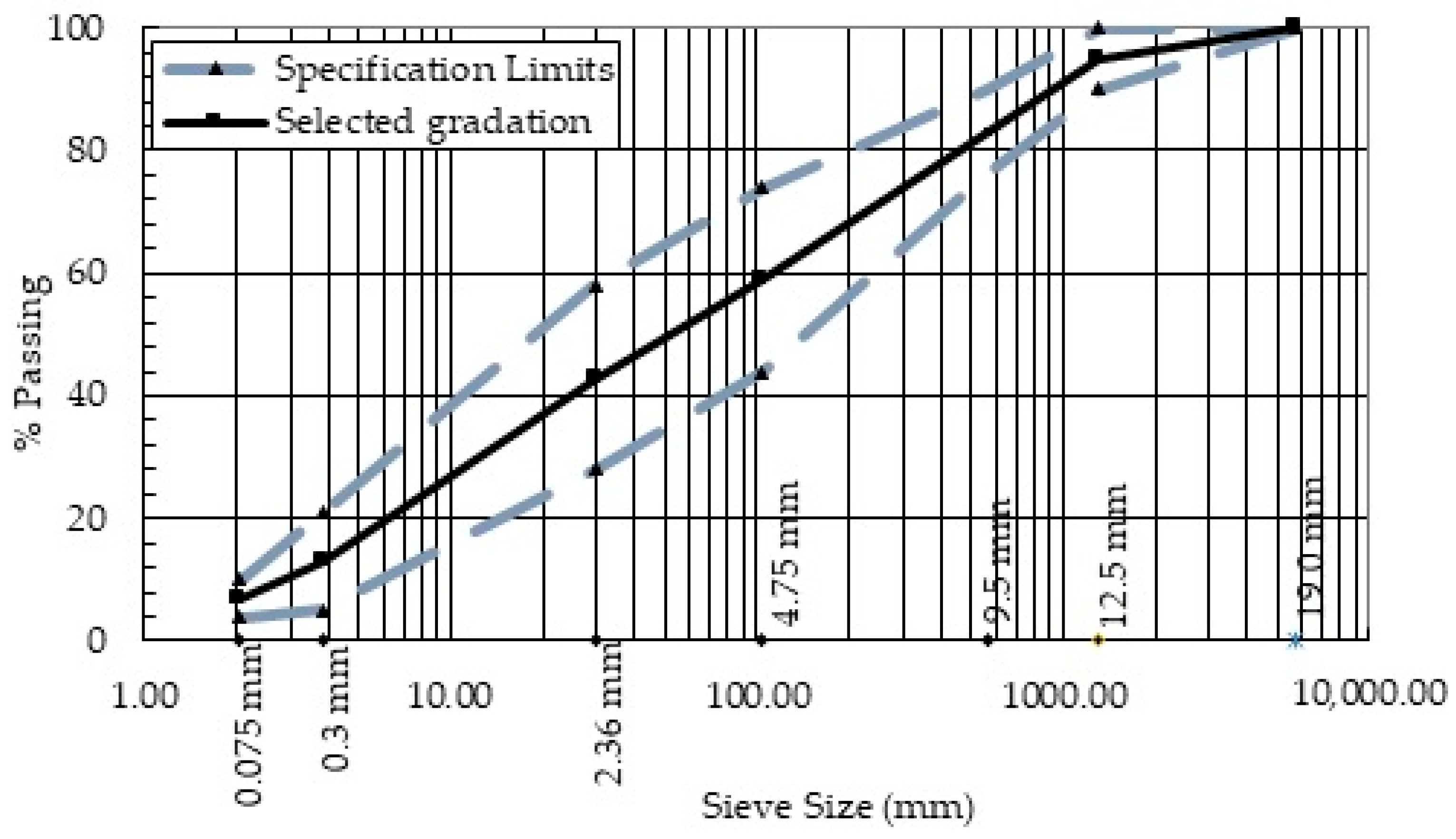

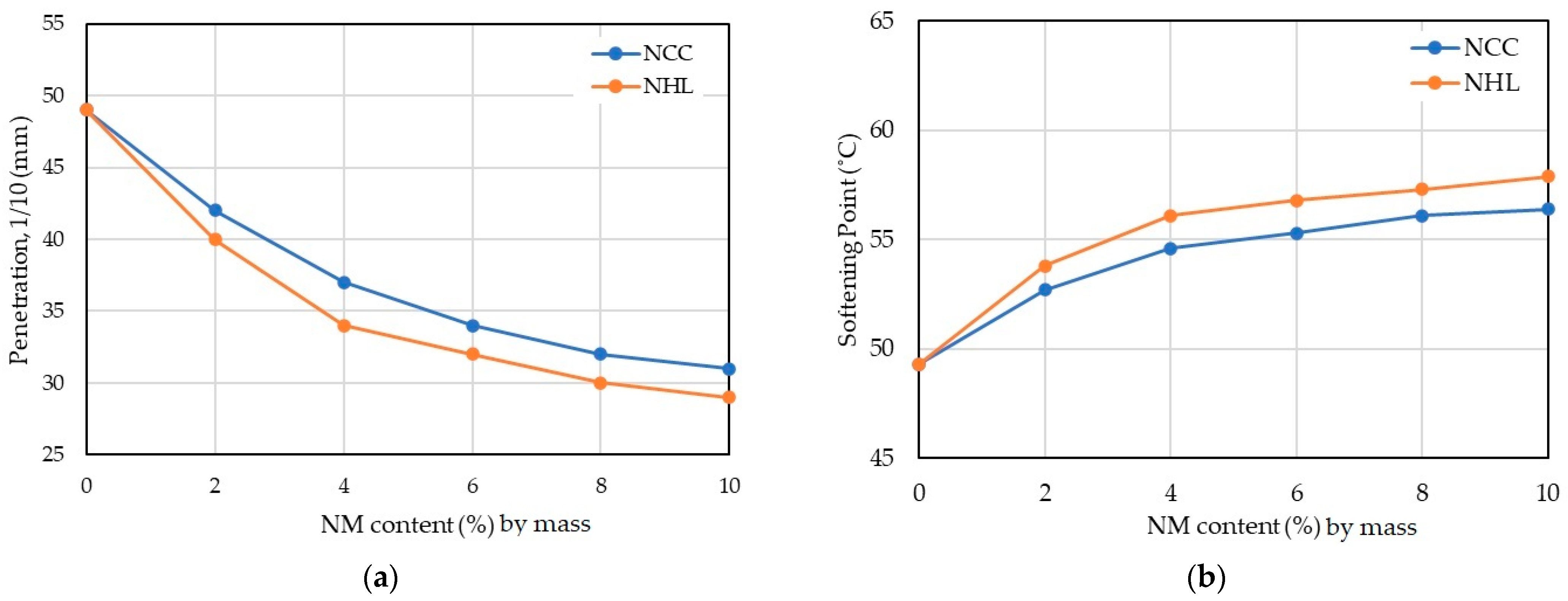



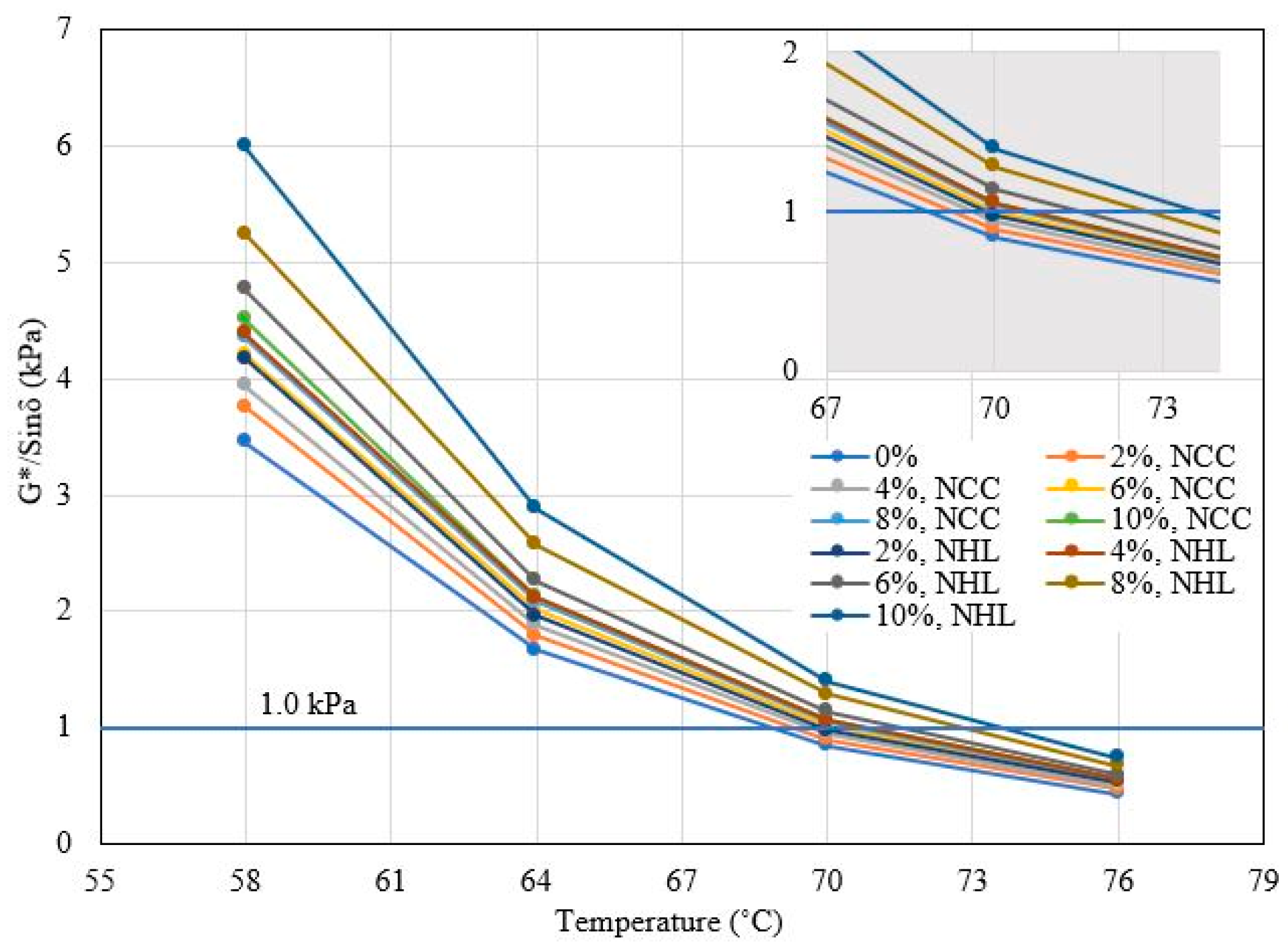
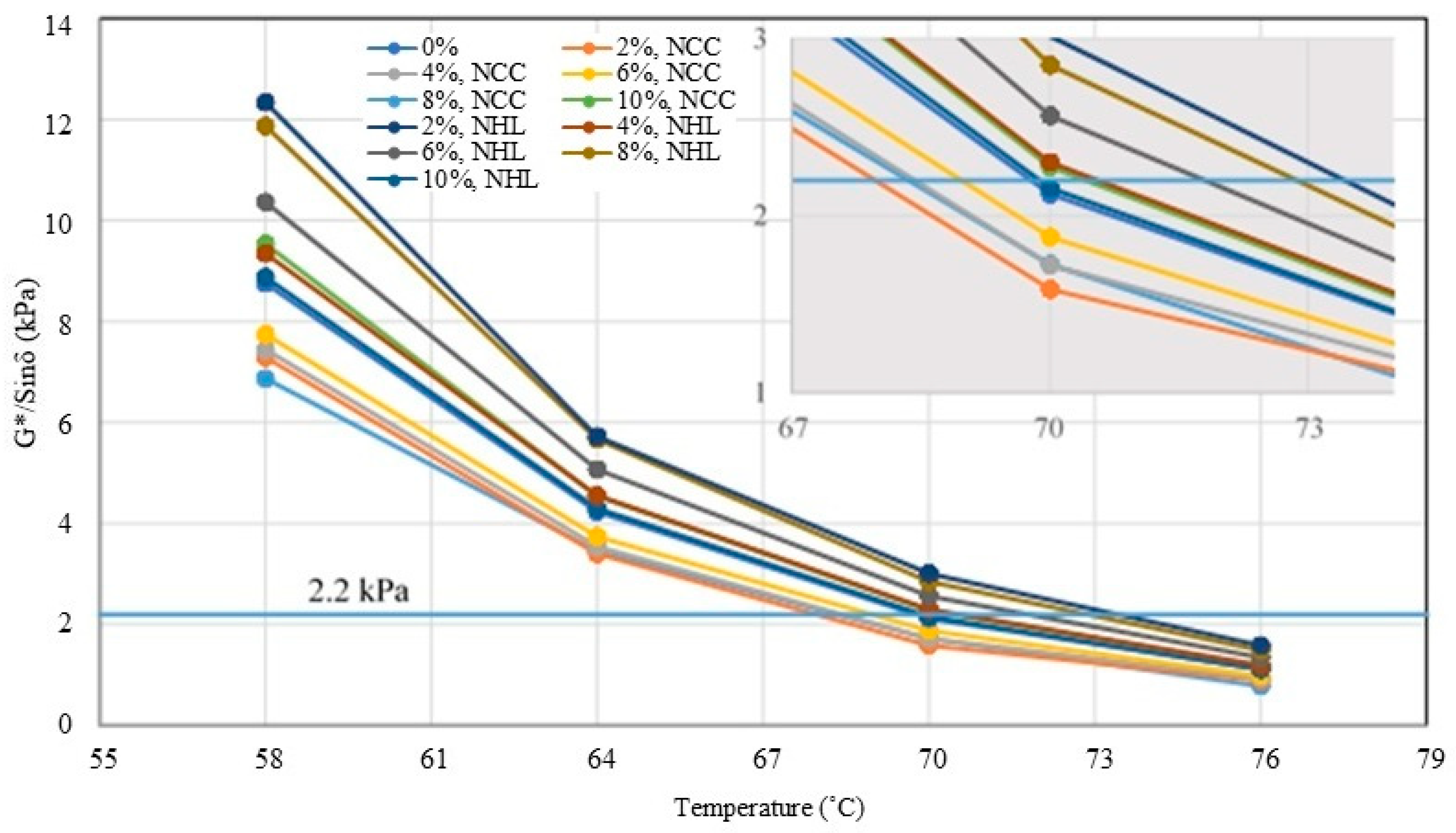

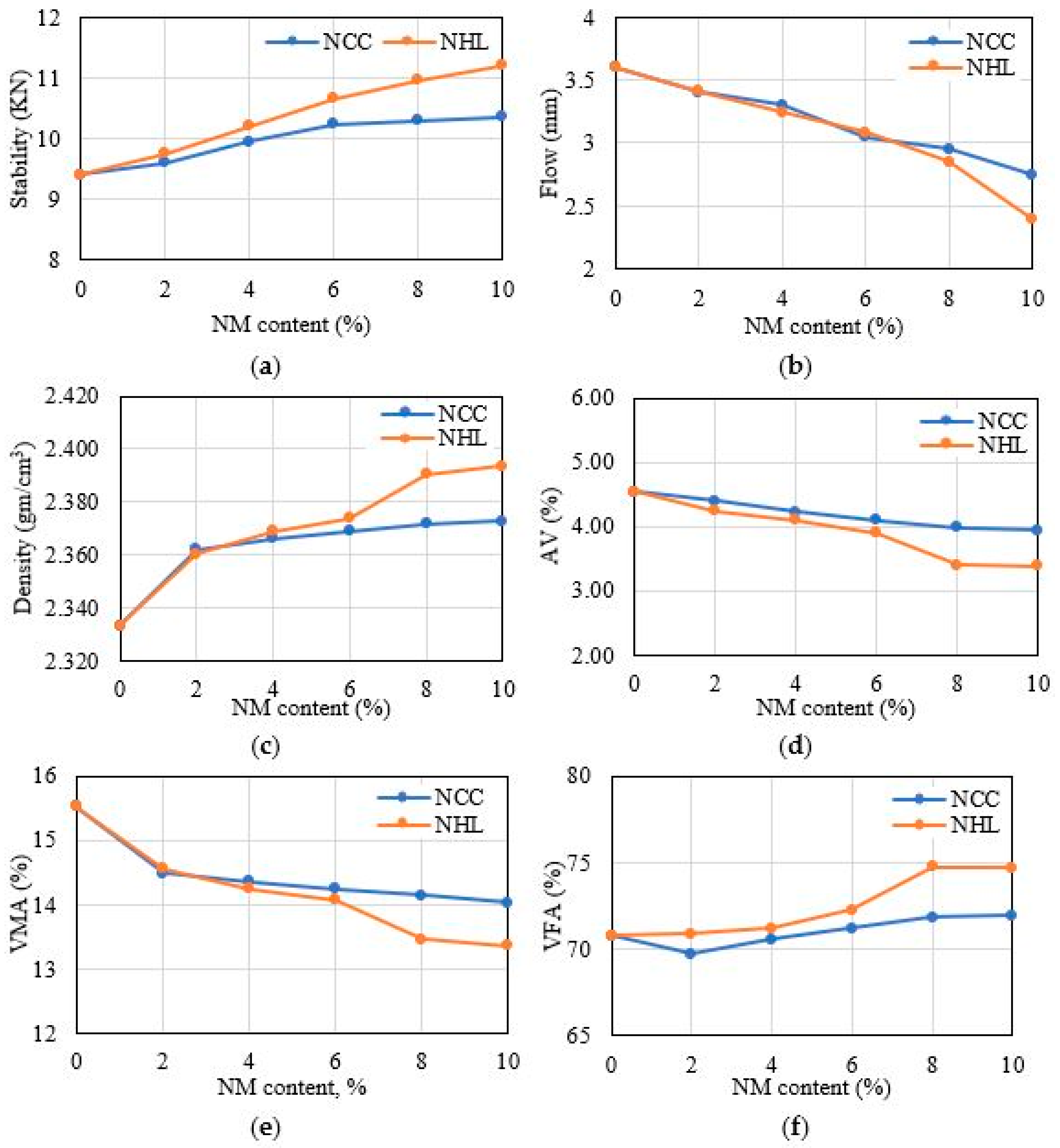

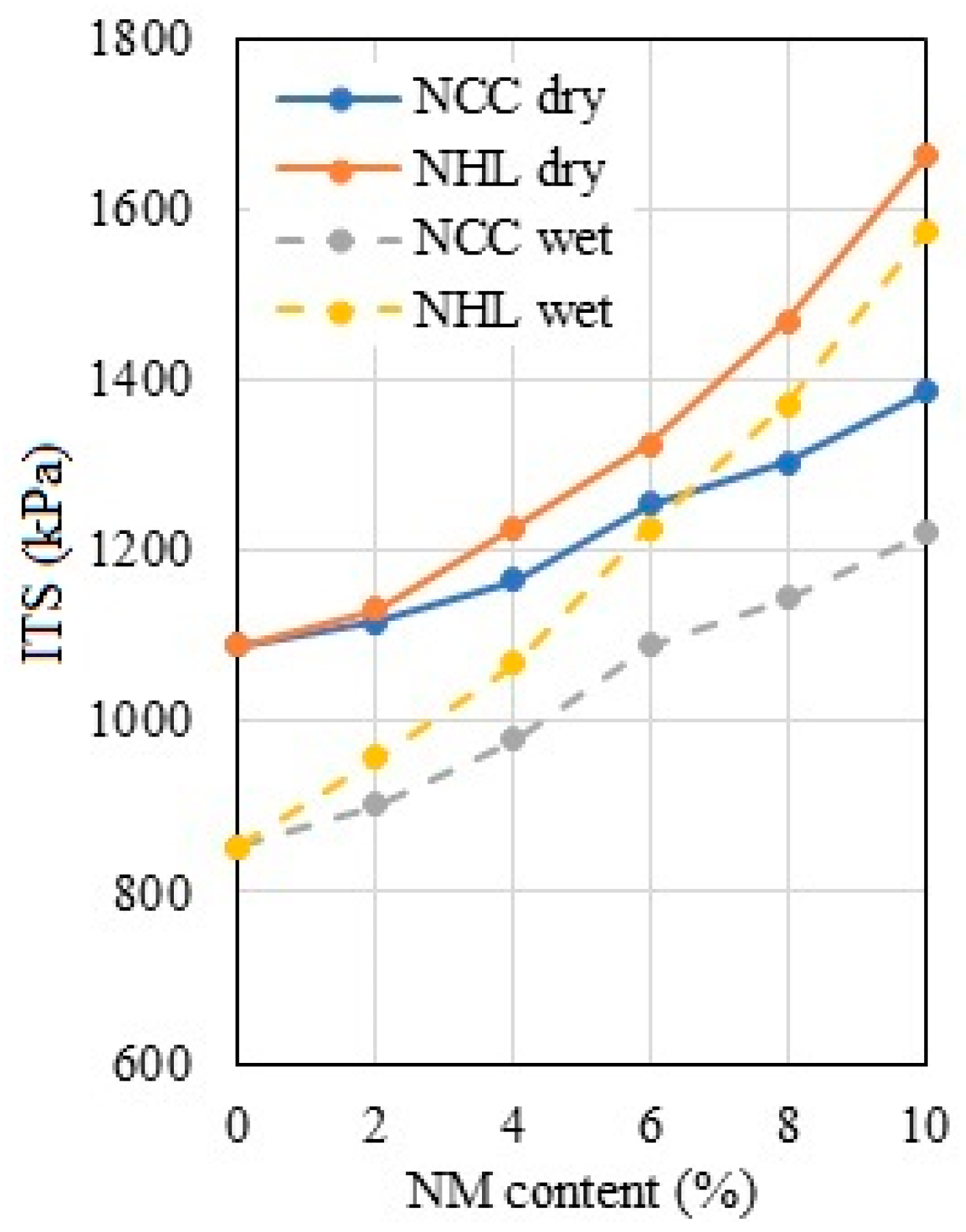
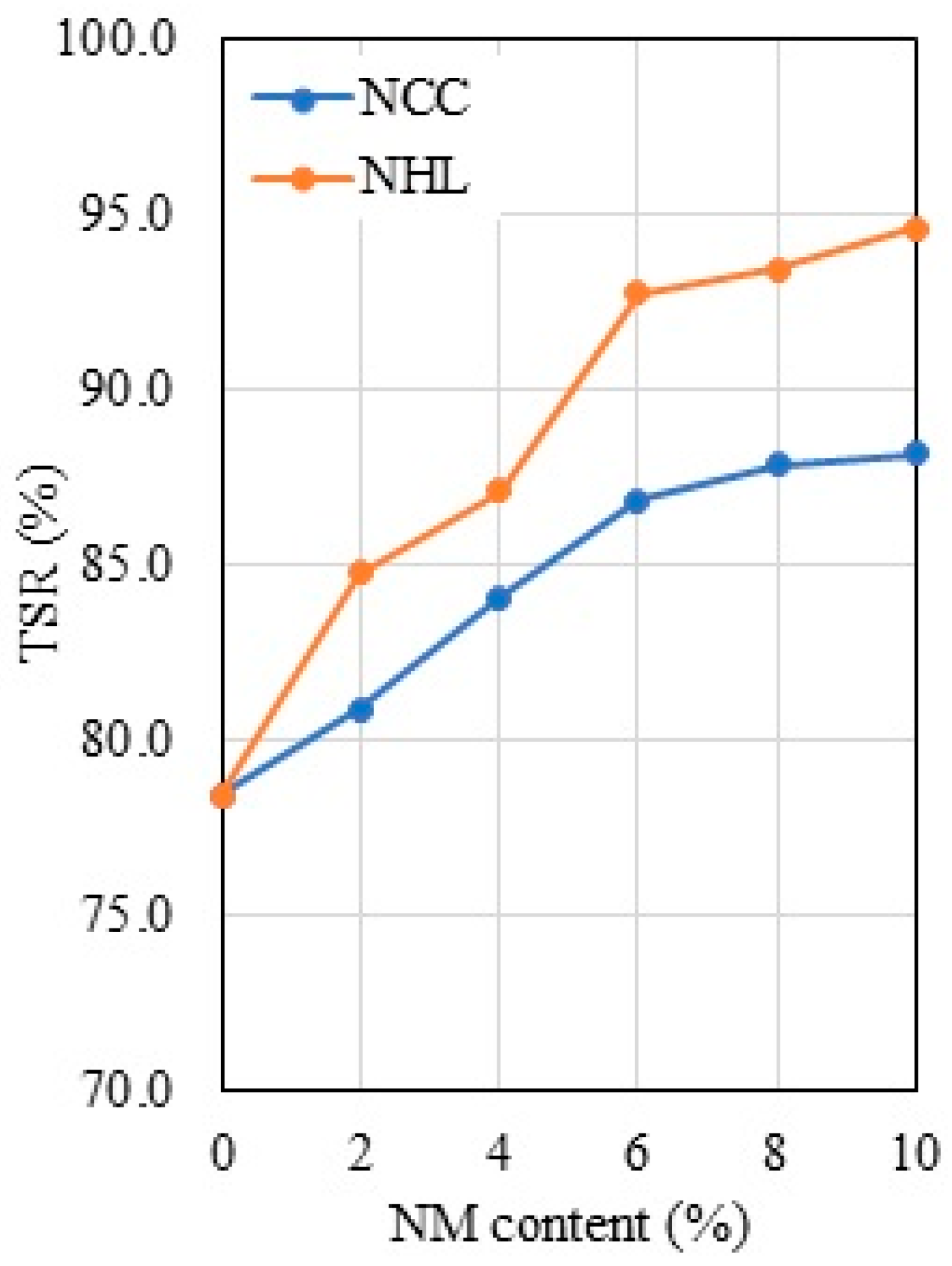



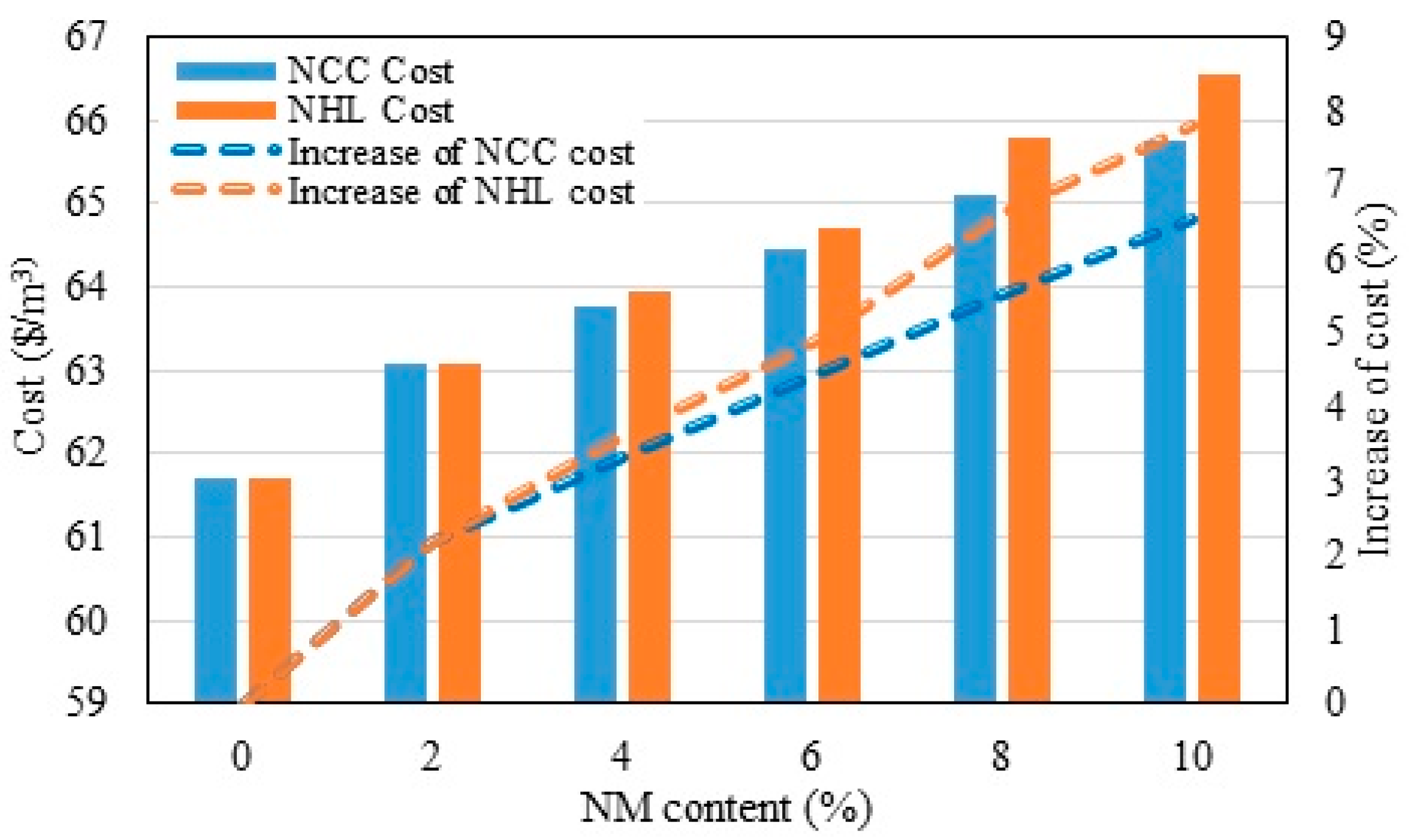

| Asphalt Cement | Properties | Measured Temperature °C | Measured Parameters | Specification Requirements, AASHTO M320 [22] |
|---|---|---|---|---|
| Original | Flash Point (°C) | - | 283 | 230 °C, min |
| Viscosity at 135 °C (Pa·s | - | 651 | 3000 m Pa·s, max | |
| DSR, G/sinδ at 10 rad/s (kPa) | 58 | 3.4515 | 1.00 kPa, min | |
| 64 | 1.6623 | |||
| 70 | 0.8425 | |||
| RTFO Aged | Mass Loss (%) | - | 0.222 | 1%, max |
| DSR, G/sinδ at 10 rad/s (kPa) | 58 | 6.8651 | 2.2 kPa, min | |
| 64 | 3.4578 | |||
| 70 | 1.7241 | |||
| PAV Aged | DSR, G.sinδ at 10 rad/s (kPa) | 28 | 3821 | 5000 kPa, max |
| 25 | 5377 | |||
| BBR, Creep Stiffness (MPa) | −6 | 187 | 300 MPa, max | |
| Slope m-value | −6 | 0.391 | 0.3, min |
| Property | ASTM Designation | Test Outcomes | Specification Requirement [23] |
|---|---|---|---|
| Coarse Aggregate | |||
| Apparent Specific Gravity | C127-15 [24] | 2.786 | - |
| Bulk Specific Gravity | 2.682 | - | |
| Water Absorption (%) | 0.314 | - | |
| Soundness (Sodium Sulfate Solution Loss) (%) | C88/C88M-18 [25] | 4.21 | 12 max. |
| Percent Wear (Los Angeles abrasion) (%) | C131/C131M-20 [26] | 21 | 30 max. |
| Flat & Elongated (5:1) (%) | D4791-19(2023) [27] | 4 | 10 max. |
| Fractured Pieces (%) | D5821-13(2017) [28] | 98 | 90 min. |
| Fine Aggregate | |||
| Apparent Specific Gravity | C128-22 [29] | 2.587 | - |
| Bulk Specific Gravity | 2.523 | - | |
| Water Absorption (%) | 0.912 | - | |
| Clay Lump and Friable Particles (%) | C142/C142M-17(2023) [30] | 1.82 | 3 max. |
| Sand Equivalent (%) | D2419-22 [31] | 61 | 45 min. |
| Mineral filler (Portland cement) | |||
| Specific Gravity | 3.17 | - | |
| Passing Sieve No. 200 (%) | 98 | 90 min. | |
| Chemical Composition (%) | Physical Properties | |||||||||
|---|---|---|---|---|---|---|---|---|---|---|
| Formula | L.O.I | SO3 | MgO | Al2O3 | SiO2 | CaO | Appearance | Particle Diameter (nm) | Bulk density (gm/cm3) | |
| Nano CaCO3 | CaCO3 | 43.2 | 0.24 | 0.32 | 0.41 | 0.43 | 55.4 | Off white powder | 30–90 | 0.67 |
| NHL | Ca (OH)2 | 26.9 | 1.12 | 1.41 | 1.3 | 0.87 | 68.4 | Pearl white powder | 10–60 | 0.45 |
| Asphalt Content (%) | 4.0 | 4.5 | 5.0 | 5.5 | 6.0 |
| Marshall stability (kN) | 5.37 | 7.12 | 9.47 | 8.44 | 7.42 |
| Flow (mm) | 1.95 | 2.55 | 3.35 | 3.75 | 4.1 |
| Density (gm/cm3) | 2.247 | 2.304 | 2.336 | 2.331 | 2.322 |
| AV (%) | 7.34 | 4.99 | 3.84 | 3.28 | 3.05 |
| VMA (%) | 16.71 | 15.302 | 14.74 | 14.84 | 15.11 |
| VFA (%) | 56.06 | 67.39 | 73.95 | 77.91 | 79.81 |
| NM Content, % | NM Type | Permanent Deformation Parameters | ||
|---|---|---|---|---|
| a | b | (εp) at N = 10,000 | ||
| 0 | - | 198 | 0.3916 | 6632 |
| 2 | Nano CaCO3 | 186 | 0.3812 | 6300 |
| NHL | 210 | 0.3622 | 5902 | |
| 4 | Nano CaCO3 | 155 | 0.3742 | 5400 |
| NHL | 175 | 0.3421 | 4300 | |
| 6 | Nano CaCO3 | 160 | 0.3655 | 4522 |
| NHL | 165 | 0.3211 | 3300 | |
| 8 | Nano CaCO3 | 135 | 0.342 | 3425 |
| NHL | 168 | 0.3101 | 2922 | |
| 10 | Nano CaCO3 | 110 | 0.331 | 2541 |
| NHL | 125 | 0.3001 | 2080 | |
| Material | Unit | Cost ($) * |
|---|---|---|
| Coarse aggregate | Ton | 11 |
| Fine aggregate | Ton | 8.16 |
| Mineral filler | Ton | 60 |
| Asphalt cement | Ton | 270 |
| NCC | Ton | 250 |
| NHL | Ton | 270 |
| Property | Control Mix | Results | |
|---|---|---|---|
| Nano CaCO3 at 4% | NHL at 6% | ||
| Marshall Stability (kN) | 9.40 | 9.95 | 10.65 |
| Flow Value (mm) | 3.6 | 3.30 | 3.08 |
| AV (%) | 4.54 | 4.23 | 3.90 |
| VMA (%) | 15.53 | 14.34 | 14.06 |
| VFA (%) | 70.77 | 70.54 | 72.27 |
| Mr (MPa) | 2680.2 | 2797.4 | 2956.23 |
| TSR (%) | 78.4 | 84.0 | 92.7 |
| (εp) at N = 10,000 microstrain | 6632 | 5400 | 3300 |
| CT index | 55.57 | 72.26 | 75.25 |
Disclaimer/Publisher’s Note: The statements, opinions and data contained in all publications are solely those of the individual author(s) and contributor(s) and not of MDPI and/or the editor(s). MDPI and/or the editor(s) disclaim responsibility for any injury to people or property resulting from any ideas, methods, instructions or products referred to in the content. |
© 2024 by the authors. Licensee MDPI, Basel, Switzerland. This article is an open access article distributed under the terms and conditions of the Creative Commons Attribution (CC BY) license (https://creativecommons.org/licenses/by/4.0/).
Share and Cite
Albayati, A.H.; Al-Ani, A.F.; Byzyka, J.; Al-Kheetan, M.; Rahman, M. Enhancing Asphalt Performance and Its Long-Term Sustainability with Nano Calcium Carbonate and Nano Hydrated Lime. Sustainability 2024, 16, 1507. https://doi.org/10.3390/su16041507
Albayati AH, Al-Ani AF, Byzyka J, Al-Kheetan M, Rahman M. Enhancing Asphalt Performance and Its Long-Term Sustainability with Nano Calcium Carbonate and Nano Hydrated Lime. Sustainability. 2024; 16(4):1507. https://doi.org/10.3390/su16041507
Chicago/Turabian StyleAlbayati, Amjad H., Aliaa F. Al-Ani, Juliana Byzyka, Mazen Al-Kheetan, and Mujib Rahman. 2024. "Enhancing Asphalt Performance and Its Long-Term Sustainability with Nano Calcium Carbonate and Nano Hydrated Lime" Sustainability 16, no. 4: 1507. https://doi.org/10.3390/su16041507
APA StyleAlbayati, A. H., Al-Ani, A. F., Byzyka, J., Al-Kheetan, M., & Rahman, M. (2024). Enhancing Asphalt Performance and Its Long-Term Sustainability with Nano Calcium Carbonate and Nano Hydrated Lime. Sustainability, 16(4), 1507. https://doi.org/10.3390/su16041507









